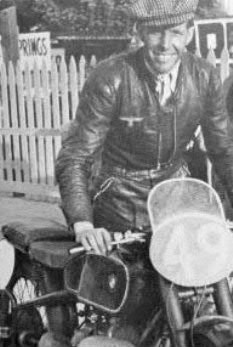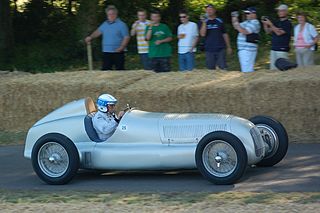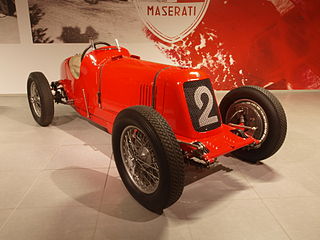
Pierre Raymond Sommer was a French racing driver. He raced both before and after WWII with some success, particularly in endurance racing. He won the 24 Hours of Le Mans endurance race in both 1932 and 1933, and although he did not reach the finishing line in any subsequent appearance at the Le Mans, he did lead each event until 1938. Sommer was also competitive at the highest level in Grand Prix motor racing, but did not win a race. He won the French Grand Prix in 1936, but the event that year was run as a sports car race.

Hans Erich Karl Josef Stuck was a German motor racing driver. Both his son Hans-Joachim Stuck and his grandsons Johannes and Ferdinand Stuck became race drivers.

Hermann Albert Lang was a German racing driver who raced motorcycles, Grand Prix cars, and sports cars.

Clemente Biondetti was an Italian auto racing driver. Born into a working-class family, Biondetti raced motorcycles before turning to automobiles where he had greater success.

Major Anthony Peter Roylance Rolt, MC & Bar, was a British racing driver, soldier and engineer. A war hero, Rolt maintained a long connection with the sport, albeit behind the scenes. The Ferguson 4WD project he was involved in paid off with spectacular results, and he was involved in other engineering projects.

Peter Nield Whitehead was a British racing driver. He was born in Menston, Yorkshire and was killed in an accident at Lasalle, France, during the Tour de France endurance race. A cultured, knowledgeable and well-travelled racer, he was excellent in sports cars. He won the 1938 Australian Grand Prix, which along with a 24 Heures du Mans win in 1951, probably was his finest achievement, but he also won two 12 Heures internationales de Reims events. He was a regular entrant, mostly for Peter Walker and Graham Whitehead, his half-brother. His death in 1958 ended a career that started in 1935 – however, he was lucky to survive an air crash in 1948.

Gianfranco Comotti was an Italian racing driver. He participated in two World Championship Formula One Grands Prix, debuting on 3 September 1950. He scored no championship points. He also participated in numerous non-Championship Formula One races.

The Mercedes-Benz W125 was a Grand Prix racing car produced by German auto manufacturer Mercedes-Benz to race during the 1937 Grand Prix season. Designed by head designer Rudolf Uhlenhaut, the car was used by Rudolf Caracciola to win the 1937 European Championship and W125 drivers also finished in the second, third and fourth positions in the championship.

Richard John Beattie Seaman was a British racing driver. He drove for the Mercedes-Benz team from 1937 to 1939 in the Mercedes-Benz W125 and W154 cars, winning the 1938 German Grand Prix. He died of his injuries after his car overturned at the 1939 Belgian Grand Prix.

Georg "Schorsch" Meier was a German motorcycle racer famous for being the first foreign winner of the prestigious Senior TT, the Blue Riband race of the Isle of Man TT Races, in 1939 riding for the factory BMW team and the first motorcycle racer to lap a Grand Prix course at over 100 mph.

The Alfa Romeo 158/159, also known as the Alfetta, is a Grand Prix racing car produced by Italian manufacturer Alfa Romeo. It is one of the most successful racing cars ever; the 158 and its derivative, the 159, took 47 wins from 54 Grands Prix entered. It was originally developed for the pre-World War II voiturette formula (1937) and has a 1.5-litre straight-8 supercharged engine. Following World War II, the car was eligible for the new Formula One introduced in 1947. In the hands of drivers such as Nino Farina, Juan Manuel Fangio and Luigi Fagioli, it dominated the first two seasons of the World Championship of Drivers.

The Alfa Romeo Tipo 308 or 8C-308 is a Grand Prix racing car made for the 3 litre class in 1938. Only four cars were produced, actually modified from Tipo C with the engine mounted lower into the chassis and a slimmer body. The chassis was derived from the Tipo C and the engine from the 8C 2900. The 308 was engineered by Gioacchino Colombo under the control of Enzo Ferrari who was then in charge of Alfa's racing team, Alfa Corse. The car debuted at the Pau Grand Prix in 1938, where two cars were entered to race, one for Tazio Nuvolari and the other for Luigi Villoresi. Both drivers had to withdraw from competition, however Nuvolari had by then set a lap record. The next race was the Tripoli Grand Prix. The new 312 and 316 were entered, but they had engine trouble during practice and Clemente Biondetti took the start at the wheel of the 308 held in reserve. He failed to finish, while Hermann Lang, driving a Mercedes-Benz W154, was the winner. In this race, Eugenio Siena, driving a 312, was killed after hitting a wall.

Captain George Edward Thomas Eyston MC OBE was a British engineer, inventor, and racing driver best known for breaking the land speed record three times between 1937 and 1939.

Giovanni “Johnny” Lurani Cernuschi, VIII Count of Calvenzano was an Italian automobile engineer, racing car driver and journalist.

The Mercedes-Benz W25 was a Grand Prix racing car designed by Daimler-Benz AG for the 1934 Grand Prix season, in which new rules were introduced, and no championship was held. In 1935, the European Championship was resumed, and it was won by Rudolf Caracciola in a W25. In modified form, the W25 remained in use until 1937, when it was succeeded by the Mercedes-Benz W125.

The Alfa Romeo Tipo 312, 312 or 12C-312 was a 3-litre formula racing car that was used in the 1938 Grand Prix season; drivers were Raymond Sommer, Giuseppe Farina, Eugenio Siena, Clemente Biondetti, Carlo Pintacuda, Jean-Pierre Wimille, Gianfranco Comotti, Piero Taruffi and Pietro Ghersi.
Alfa Romeo Tipo 316, 316 or 16C-316 Grand prix car was used in Grand Prix seasons 1938 and 1939, when it was driven by Giuseppe Farina and Clemente Biondetti. The Tipo 316 was one of three Alfa Romeo cars designed for the new rules in 1938, which differed mainly by the engine, the other two were the Alfa Romeo Tipo 308 straight-8 and Alfa Romeo Tipo 312 with a V12 engine. The car was based on Alfa Romeo 12C-37. It had roots supercharged 60 degree engine from 2,958 cc (180.5 cu in) capacity 58 mm × 70 mm produced 350 bhp (261 kW) at 7500 rpm. The engine was more powerful than the one in Tipo 308 or 312, but it was still not really competitive against Germans.
Vittorio Belmondo was an Italian racing driver. He entered 23 races in Maseratis and Alfa Romeos between 1934 and 1938, his best results being one victory, one second place and three third places.

The 1936 Vanderbilt Cup was a Championship Car race that was held on October 12, 1936 at Roosevelt Raceway near Westbury, New York. It was the fourth and final race of the 1936 AAA Championship Car season, not counting the non-championship events. The race, contested over 75 laps of 6.39 km (3.97 mi), was won by Tazio Nuvolari driving a Alfa Romeo 12C-36 from eighth starting position.

The Maserati 4CM is an open-wheel Grand Prix motor racing car, designed, developed and built by Italian manufacturer Maserati, in 1931.
















